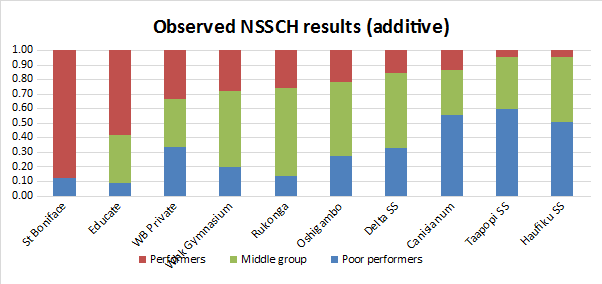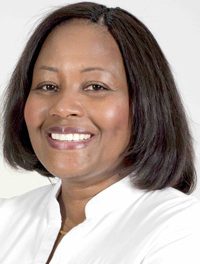
Drivers of performance in Namibian secondary education

By Dr Helmke Sartorius von Bach.
The previous article in the series can be read here: https://economist.com.na/42075/columns/how-namibian-grade-12-students-performed-over-the-past-two-decades/
It is known that government investment in health, education and infrastructure is a contributor to human capital formation. Therefore, it is critical to understand the requirement for senior secondary education to determine the drivers of student performance.
It is generally hypothesized that quality of educational output results from spatial location, resource allocation and further opportunities. Differences between schools need to be understood to assess the existence of regional variation of socio-economic circumstances of learners, teachers and the school location.
In Namibia, the skewness within the Namibian Senior Secondary Certificates (higher level) can be attributed to historic development, which resulted into a large degree of residential segregation, based on household income, cultural and/or ethnic background.
The data shows that on a national basis, the average NSSCH students’ total point decreased from 20.1 in 1999 to 8.55 in 2013 and increased marginally since then to 9.99 in 2018. The data also shows that some schools’ performance are much higher than others, that many of the top performers were female students, and that schools with a religious foundation in general performed better. However, no statistical proof could be provided on a national or regional level. To understand the drivers of educational performance, the effect of schools was used to demonstrate regional performance, which could be interpreted as levels of managing secondary schools.
Educational performance between the urban node of Namibia (Khomas region with its capital city Windhoek), and the remaining regions with rural characteristics were presented. Disaggregating the private schools from the government schools, it is interesting to observe that private NSSCH schools generally performed better, both in absolute and relative terms. The relatively high number of private schools in Khomas is probably the reason why the educational performance was better than in other regions.
Empirical evidence shows that Khomas government schools lost their share of producing top performers, and unfortunately increased the number of poor performers. This is the opposite of the economic theory for a functional node but corresponds to the national trend. The educational NSSCH performance is illustrated in the next figure.
Average NSSCH student points:

Three distinct phases can be observed.
The first phase shows increasing average student points from 1996 to 1999. This could be correlated to the returns of the national education wages and salaries adjustments though WASCOM in 1994.
The next phase is the flattening and decline of results until 2013. The trend of phase one and phase two corresponds to the educational decision to end incentive payment for teachers after obtaining their Higher Education Diploma.
Only during Phase 3 between 2013 and 2018, the system could halt the trend of declining points with a slight increase in average marks during the last two years. The graph thus points out, that well-paid teachers contribute to improved student performance.
It is well-known that teachers at private schools earn higher remuneration, and evidently, to take the Khomas example, its government schools only perform 40% of private schools. It must be noted, that other factors such as availability of educational resources also play a significant role in performance in secondary education.
Based on the low averages and relatively few performers, the question to be asked is where the performing students originated from?
The Central Place Theory and urban economic state that the urban hubs provide better resources resulting in better outcomes. The assessment therefore presents different types of schools within the functional node to determine how central region performance compares to the remaining regions.
This lead to present the differences within types of NSSCH schools to determine what caused the delivering of performing students to the pool of excellence, i.e. whether investments into decentralized education slowly started to pay off.
Attributes of an environment for performance was tested by using a sample of known performing regional schools from 2018 as presented in the table below.

From the table, it is clear that on average, the results of these selected schools are almost double their specific regional average. Generally, students in the private schools performed better but some variation exists. It appears that the different schools’ average point is the result of the specific school’s leadership. This explains the huge performance variation, i.e. school management can be taken as a driver of NSSCH performance and consequently of human capital formation.
Augustineum Senior Secondary school was selected to represent a relatively resource-poor Namibian school. Their average grade 12 student of 2018 achieved 5.37 NSSCH points plus 13.25 NSSCO points. With a total average point of 18.62, these students did not meet tertiary requirements for future employment in general.
All other selected schools in the table represent NSSCH with the high-end performers. The best average performing schools for 2018 were St Boniface College with 40.85 NSSCH points, followed by Educate Academy with 39.42 NSSCH points. It should be noted that both these schools are located in rural regions, and not in the well-resourced Khomas hub. This trend is different to the historic pattern when performing schools originated from the urban capital region. The best private school for 2018 in Khomas region was Windhoek Gymnasium with an average of 29.12 NSSCH points.
To analyse school performance, the student’s final exam results from 2018 were divided into high performers, poor performers and the middle group. The figure below clearly shows three classification types. Although these schools performed well, the classification criteria could be applied to the majority of schools who generated less than 1% of performers in the 2018 academic year. The types are discussed below.
• Samples of type A schools are St Boniface College and Educate Academy, with achieved outputs of which the majority of students are classified as high performers. This was only possible because of their significantly different operational approach and not the classification of private or public school. Their success driver can be categorized as school leadership and guidance from their school board.

• The sample for type B schools includes Windhoek Gymnasium, Walvis Bay Private, Rukonga Vision and Oshigambo High school, where the portion of top performers are more than the poor performers. Their middle group consists of the highest percentage of students, only because of the size of the school. The objective remains that the group of poor performers must remain the minority.
• The sample for type C schools includes Canisianum Roman, Gabriel Taapopi, and Haimbili Haufiku Senior Secondary schools, which produced a significant number of top performers but have no control over the number of poor performers, i.e. management allows poor performers to dominate. Delta Senior Secondary is classified as a type B/C school.
• The majority of Namibian senior secondary schools could be classified into school type C. Augustinemun Senior Secondary, presented in the table above is an example of this type. Very few of these schools generate high performing students. Typically more than 75% of their students were categorized as poor performers. Performance is certainly attributed to resource availability and school management in general, but also driven by the principle of majority allowing poor performance.
From the series of the Namibian NSSCH articles, it is clear that school performance historically differed because of historic disparities but that governments’ investment in education and its decentralization policy slowly started to show positive results. Unfortunately, since school resources remain limited, it is the key factor contributing to the prevailing low average performance in Namibian secondary education.
The discussion shows that the implementation of the NSSCH school system resulted in increased numbers and more equity, but that skewness remains in Omusati, Oshana and Ohangwena. Furthermore, the educational democracy principle of equal rights, opportunity and treatment within regions show that further attention should be given in the Kunene, Otjozondjupa, Omaheke and Hardap regions.
While the Namibian youth could be Namibia’s biggest asset, the series of articles illustrates that if secondary education does not benefit from availed resources, our millennials could become the country’s biggest liability.
Effective school management systems, teacher compensation based on performance, and significant improvement of resource availability are required to produce students capable and able to take up jobs again.










































